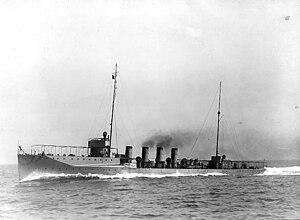Třída Aylwin
| Třída Aylwin | |
|---|---|
 USS Benham (DD-49) | |
| Obecné informace | |
| Uživatel | US Navy |
| Typ | torpédoborec |
| Lodě | 4 |
| Osud | vyřazeny |
| Předchůdce | třída Cassin |
| Nástupce | třída O'Brien |
| Technické údaje | |
| Výtlak | 1010 t (standardní) 1235 t (plný) |
| Délka | 91,5 m (na vodorysce) 93,1 m (max.) |
| Šířka | 9,2 m |
| Ponor | 3 m |
| Pohon | turbíny parní stroj 4× kotel |
| Rychlost | 29 uzlů |
| Posádka | 98 |
| Výzbroj | 4× 102mm kanón (4×1) 8× 450mm torpédomet (4×2) |
Třída Aylwin byla třída torpédoborců námořnictva Spojených států amerických. Celkem byly postaveny čtyři jednotky této třídy. Torpédoborce byly nasazeny za první světové války a roku 1935 vyřazeny. Některými prameny jsou považovány za součást předcházející třídy Cassin.[1]
Stavba
Stavba této třídy byla hrazena ve finančním roce 1912.[2] V letech 1912–1914 byly postaveny celkem čtyři torpédoborce této třídy. Všechny postavila loděnice Cramp ve Filadelfii.[1]
Jednotky třídy Aylwin:[1]
| Jméno | Loděnice | Založení kýlu | Spuštěna | Vstup do služby | Osud |
|---|---|---|---|---|---|
| USS Aylwin (DD-47) | Cramp | březen 1912 | 23. listopadu 1912 | leden 1914 | Vyřazen 1935. |
| USS Parker (DD-48) | Cramp | březen 1912 | 8. února 1913 | prosinec 1913 | Vyřazen 1935. |
| USS Benham (DD-49) | Cramp | březen 1912 | 22. března 1913 | leden 1914 | Vyřazen 1935. |
| USS Balch (DD-50) | Cramp | březen 1912 | 21. prosince 1912 | březen 1914 | Vyřazen 1935. |
Konstrukce


Základní výzbroj tvořily čtyři 102mm kanóny Mk.IX v jednohlavňových postaveních a čtyři dvojhlavňové 450mm torpédomety. Za války byly přidány dvě skluzavky hlubinných pum a jeden vrhač (Y-gun). Pohonný systém tvořily dvě parní turbíny Parsons, dva parní stroje (VTE) pro cestovní rychlost a čtyři kotle Normand. Lodní šrouby byly dva. Výkon pohonného systému byl 16 000 hp. Nejvyšší rychlost dosahovala 29 uzlů.[1]
Služba
Všech šest plavidel bylo ve službě za první světové války. Žádný nebyl ztracen. Vyřazeny byly roku 1935.[1]
Odkazy
Související články
Reference
- ↑ a b c d e CASSIN destroyers (1913-1915) [online]. Navypedia.org [cit. 2018-12-15]. Dostupné online. (anglicky)
- ↑ Aylwin Class [online]. Destroyerhistory.org [cit. 2018-12-15]. Dostupné online. (anglicky)
Externí odkazy
 Obrázky, zvuky či videa k tématu třída Aylwin na Wikimedia Commons
Obrázky, zvuky či videa k tématu třída Aylwin na Wikimedia Commons - Aylwin Class [online]. Destroyerhistory.org [cit. 2018-12-15]. Dostupné online. (anglicky)
Média použitá na této stránce
Autor: Internet Archive Book Images, Licence: No restrictions
USS Parker (DD-48) - The torpedo boat Parker which was on mail duty with the fleet.
Identifier: peopleswarbookhi00mill (find matches)
Title: The people's war book; history, cyclopaedia and chronology of the great world war
Year: 1919 (1910s)
Authors: Miller, J. Martin (James Martin), b. 1859 Canfield, Harry S. (from old catalog), joint author Plewman, William Rothwell, 1880- (from old catalog) Foch, Ferdinand, 1851-1929 Lloyd George, David, 1863-1945 United States. President (1913-1921 : Wilson)
Subjects: World War, 1914-1918 World War, 1914-1918
Publisher: Cleveland, O., The R.C. Barnum co. Detroit, Mich., The F.B. Dickerson co. (etc., etc.)
Contributing Library: The Library of Congress
Digitizing Sponsor: Sloan Foundation
View Book Page: Book Viewer
About This Book: Catalog Entry
View All Images: All Images From Book
Click here to view book online to see this illustration in context in a browseable online version of this book.
Text Appearing Before Image:
o battle thesubmarine. It has been a reserve forcewhich would have come into play had anyreverse at sea befallen the fleets of theEuropean allies. Brazil has also contributed vessels to theguarding of the Atlantic against the sub-marine, and Greek vessels, since Const an-tine was expelled, have aided in the patrolof the eastern Mediterranean. From a purely materialistic viewpointthe Hun did not unwisely in pinning hisfaith to the submarine. It has taken theunited sea power of the free nations to putdown its menace. Where the Hun miscal-culated was, first, in l)elieving that victorycould be won by land power without pre-dominating sea power; second, in so usinghis sea power as to make it clear that therecould be no safety for the rest of the worlduntil the Hun was not only swept from theseas, but also ground to powder on land. The end of the war came with startlingswiftness. Almost as suddenly as it brokeupon the world, it collapsed in an abjectdefeat, not only of the German army, but,
Text Appearing After Image:
294 THE PEOPLES WAR BOOK much more significant, in the defeat anderadication of the German idea. On July 15, 1918, the German armiesarmies were threatening Paris. The cap-ital of France was under bombardment bythe seventy-five-mile gun. The troops ofthe United States were just beginning toarrive in sufficient numbers to constitutea real force. A great German drive startedon the Marne. There it stopped, and inthree days it was turned back into one ofthe great defeats of history, and since thatdate the allies have enjoyed an unbrokenprocession of victories, while the Centralpowers have fallen apart until there is leftonly Germany, with its cowering war lordrunning to take refuge from his peoplewith his armies. It is a dii¥erent picture the blustering-beast of Potsdam now presents from thepompous general seeking to conquer thecontinent of Europe and extend his do-minions into Asia. Hand in hand with amade in Germany Gott, he promised hispeople the countries of Europe as their reward for
Note About Images
Removed caption read: Photo # NH 56377 USS Benham leaving Brest harbor, France, 22 October 1918
USS Benham (Destroyer # 49) making 31.774 knots during sea trials, 16 December 1913.


